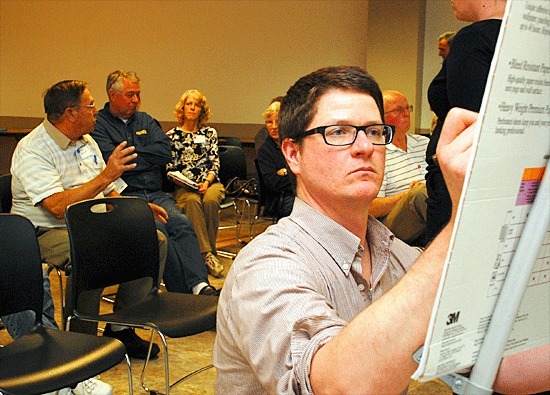The future of shoreline development in Oak Harbor was the focus of a July 22 community planning meeting at Skagit Valley College.
Centered on the city’s effort to overhaul its shoreline master program, a planning document that regulates development on about 12 miles of waterfront in Oak and Crescent harbors, the meeting was held so city planners could get public input before completing the update.
About 13 people, not including city and county officials, attended the workshop. Most were property owners that live on or near the city’s shoreline.
“I thought it was a real good meeting,” said Fred Walrath, a Bayshore Drive resident. “They really listened and that’s a start in the right direction.”
The city is updating its master program to incorporate new state guidelines that were adopted in 2003. The guidelines, which have since been further revised, are designed to reflect the broader policies of the Shoreline Management Act of 1971 and include advancements in science, shoreline management practices, and changes resulting from the passage of the Growth Management Act of 1990.
Also present at the workshop were two representatives of AHBL, a Seattle-based consulting firm the city hired to create a shoreline inventory and character report. The work, along with the larger update effort, is being funded by a $125,000 grant from the state Department of Ecology.
Due to the topic’s complexity, much of the meeting was devoted to explaining just what a master program is and how the state’s new guidelines may affect the community. It should be noted that the “guidelines” are more akin to rules, as they are the criteria the Department of Ecology uses to review the city’s updated plan.
The agency has the power to approve or reject the document.
“The word ‘guidelines’ is a little misleading,” AHBL Project Manager Gabe Snedeker said.
As is the case now, master programs have jurisdiction over property within 200 feet of the ordinary high-water mark. It determines how such properties are developed, from how it is used to landscaping and vegetation. The new guidelines focus around the idea of “no-net loss.”
“In simple words, you can’t make it worse than it is today,” Snedeker said.
While a range of subjects were addressed, topics such as the guidelines’ focus on shoreline restoration and the avoidance of antiquated beach stabilization techniques, like the installation of bulkheads, brought about the most questions.
Following a question by Harvey Herrigstad of SW Scenic Heights Street about just who is expected to foot the bill, Oak Harbor City Councilman Jim Campbell said words like “restoration” make people nervous that they will be required to pay for changes they can’t afford.
Snedeker said master programs can put a heavy burden on new development, but they don’t have the power to force property owners to alter existing homes or infrastructure. They are proactive, rather than retroactive.
“There’s no bulkhead police,” Snedeker said.
Other areas of concern from the attending public focused on pollution in Oak Harbor bay and the location of the future wastewater treatment plant.
Jim Matthews asked if the existing “Rose Bowl” could be moved out of Windjammer Park while Walrath said the master program should help clean up the water and beach.
“We’ve lost all the fishing in the bay to pollution and loss of habitat,” Walrath said.
On another note, Scenic Heights resident Ann Liszak said the master program should address stormwater discharge, starting with the city’s pipe that goes through her backyard and dumps water over the edge of the bluff on her high-bank property.
“I’ll tell you what’s not helping is the city drainage pipe running through my property,” she said.
Liszak then gave Snedeker informational pamphlets the Department of Ecology provides to landowners for free about how to take care of shoreline property.
“You can keep that,” she said.
The city has until Dec. 1, 2012, to finish the update and there is still plenty of opportunity for public comment. A shoreline advisory committee, consisting of seven members, began meeting this month and will continue to do so monthly for about a year.
Committee members include: Keith Fakkema, a member of the Oak Harbor Planning Commission; Helen Chatfield-Weeks, a member of the Oak Harbor Park Board; Jill Johnson, director of the Oak Harbor Chamber of Commerce; Christon Skinner, chair of the Marina Advisory Committee; Mahmoud Abdel-Monem, a member of the Island County Planning Commission; Jennifer Meyer, community liaison for Whidbey Island Naval Air Station; and Rick Almberg, an Oak Harbor city councilman.
The master program update must be reviewed by the Oak Harbor Planning Commission, the city council, and finally the Department of Ecology. Each has their own process that allows for public comment.



